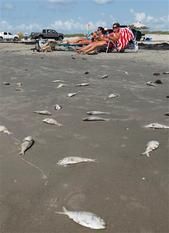
Increased concentrations of red tide algae likely left hundreds of thousands of dead fish washed up over the weekend on Galveston beaches, the Galveston County Daily News reports.
Low to moderate concentrations of the neurotoxic algal bloom were the probable cause of the fish kill that left the huge numbers of dead shad - also known as Gulf menhaden - on the island's West End beaches, an official told the newspaper, after testing revealed the presence of red tide.
The Galveston Island Park Board of Trustees brought in extra workers to deal with the fish kill and said it would clear the fish away by Wednesday if there were no more fish kills.
The presence of the algae prompted the Texas Department of State Health Services on Monday to close what little oyster harvesting was ongoing by public lease holders in Galveston Bay, department spokesman Chris Van Deusen told the newspaper.
Red tide is a single-cell organism that accumulates in shellfish and can cause illness in people who consume them. In large concentrations, the algal bloom becomes visible as a brown or red discoloration floating on the surface waters.
The Texas Parks and Wildlife Department plans to continue testing the waters this week and to distribute red tide information sheets to Galveston officials to pass on to beachgoers.
Greg Barr runs the day-to-day operations of the HBJ newsroom and website, as well as overseeing the weekly executive living section, H-Town.



Reader Comments
to our Newsletter